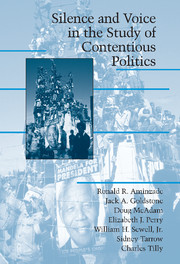Book contents
- Frontmatter
- Contents
- Preface
- 1 SILENCE AND VOICE IN THE STUDY OF CONTENTIOUS POLITICS: INTRODUCTION
- 2 EMOTIONS AND CONTENTIOUS POLITICS
- 3 SPACE IN CONTENTIOUS POLITICS
- 4 IT'S ABOUT TIME: TEMPORALITY IN THE STUDY OF SOCIAL MOVEMENTS AND REVOLUTIONS
- 5 LEADERSHIP DYNAMICS AND DYNAMICS OF CONTENTION
- 6 THE SACRED, RELIGIOUS, AND SECULAR IN CONTENTIOUS POLITICS: BLURRING BOUNDARIES
- 7 THREAT (AND OPPORTUNITY): POPULAR ACTION AND STATE RESPONSE IN THE DYNAMICS OF CONTENTIOUS ACTION
- 8 CONTENTION IN DEMOGRAPHIC AND LIFE-COURSE CONTEXT
- 9 HARMONIZING THE VOICES: THEMATIC CONTINUITY ACROSS THE CHAPTERS
- References
- Index
7 - THREAT (AND OPPORTUNITY): POPULAR ACTION AND STATE RESPONSE IN THE DYNAMICS OF CONTENTIOUS ACTION
Published online by Cambridge University Press: 05 June 2012
- Frontmatter
- Contents
- Preface
- 1 SILENCE AND VOICE IN THE STUDY OF CONTENTIOUS POLITICS: INTRODUCTION
- 2 EMOTIONS AND CONTENTIOUS POLITICS
- 3 SPACE IN CONTENTIOUS POLITICS
- 4 IT'S ABOUT TIME: TEMPORALITY IN THE STUDY OF SOCIAL MOVEMENTS AND REVOLUTIONS
- 5 LEADERSHIP DYNAMICS AND DYNAMICS OF CONTENTION
- 6 THE SACRED, RELIGIOUS, AND SECULAR IN CONTENTIOUS POLITICS: BLURRING BOUNDARIES
- 7 THREAT (AND OPPORTUNITY): POPULAR ACTION AND STATE RESPONSE IN THE DYNAMICS OF CONTENTIOUS ACTION
- 8 CONTENTION IN DEMOGRAPHIC AND LIFE-COURSE CONTEXT
- 9 HARMONIZING THE VOICES: THEMATIC CONTINUITY ACROSS THE CHAPTERS
- References
- Index
Summary
As compared with the fiercely repressive 1970s, the 1980s opened more opportunities to South Africa's black activists. International support for their cause was rising, black educational enrollment was increasing, color bars on employment were disappearing, and black trade unions had become legal. The South African government's abortive attempt to coopt mixed race (Coloured) and Indian citizens through the creation of separate, subordinate parliaments, furthermore, made blanket repression more difficult for the state to manage. Still, up to the decade's end threats abounded. The Black Authorities Act (1983) spurred local councils to raise rents, evict defaulters, and raze illegally constructed shacks; governmental forces tightened their surveillance of militants; and in July 1985 beleaguered premier P. W. Botha declared a state of emergency.
In the face of significant repression, the early 1980s saw widespread formation of local civic associations and significant expansion of worker militancy in general (Price 1991:162–82). The banned African National Congress (ANC) and Black Consciousness (BC) movement joined forces in the creation of a vast United Democratic Front (UDF) from 575 disparate organizations. The UDF drew on connections established by the BC and ANC, but went well beyond them. In 1985 a similar (and, in fact, overlapping) coalition of trade unions formed COSATU, the Congress of South African Trade Unions. Those well-connected organizations coordinated widespread resistance to the regime. Despite the state of emergency in most industrial centers, despite banning of many community organizations, and despite detention of thousands of activists without trial, black mobilization accelerated during the 1980s.
- Type
- Chapter
- Information
- Silence and Voice in the Study of Contentious Politics , pp. 179 - 194Publisher: Cambridge University PressPrint publication year: 2001
- 284
- Cited by

